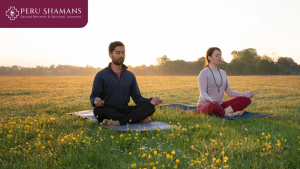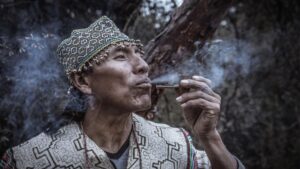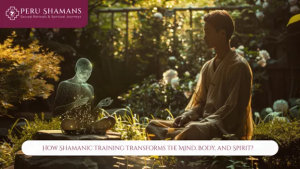People join shamanic retreats for many reasons. Some want healing, and some want peace. Some look for meaning in life. These places are not only about rest. They include special rituals that help people with self-discovery. Rituals bring structure and meaning. They also bring a sense of connection. They have been part of human life for centuries. In these places, they become a path to healing and change.
The Importance of Rituals in Shamanic Retreats
Shamanic retreats place rituals as the main part of the experience.
The first line of this place is about creating a safe and sacred space. The rituals make this possible.
Rituals give people a way to pause and step out of daily life. When someone enters this place, they leave behind noise and problems. Rituals help mark this change. They act as a bridge between the outside world and the inner trip. In this space, people can focus on their feelings and healing. Without rituals, this experience may feel incomplete and will lack direction.
Understanding Sacred Rituals
These are more than actions. They are symbols that carry meaning. Lighting a candle and chanting may seem simple. But here, these acts take on more importance. They signal respect for the process and create unity among participants.
These rituals invite people to connect with something larger than themselves. Some feel closer to nature. Others feel the presence of spirit. The common thread is a sense of being held and supported. Rituals help people through emotions. They help release old pain. They open space for new insights.
Connection to Ancient Healing Traditions
Many of the practices link back to ancient healing traditions . Long before modern medicine, people used rituals to heal mind and body. They believed illness was not just physical but also emotional and spiritual. Shamans played the role of healer and connector between worlds.
These old traditions survive in these places. It can be through drumming and chanting. It can also be in the form of guided ceremonies. These rituals carry the wisdom of ancestors. They remind people that healing is not only about the body. It is also about harmony with self and nature. This connection to the past makes this place feel powerful.
The Role of Ceremony in Healing
This may involve fire and water. It may also involve sound. Each element represents something important.
- fire for letting go
- , water for cleansing
- , sound for awakening
People take part with respect. They know that each act carries meaning.
These ceremonies are not about religion. They are about creating a space where people feel safe to heal. When someone takes part, they feel part of a bigger story. The simple act of giving gratitude and setting an intention can lead to change.
Music and Rhythm in Rituals
This plays a key role in many ceremonies. The steady beat of drums and the soft sound of rattles help people enter a relaxed state.
Rhythm has a way of calming the mind and guiding attention inward. In shamanic retreats , these sounds are used during ceremonies to support meditation. The vibration of music can also create a sense of unity within the group. People feel connected not only to the sound. But also to each other. This simple and powerful use of rhythm has been part of ancient healing traditions for centuries.
Group Rituals and Shared Experience
One strong part of these places is the group energy.
When people join together in ritual, they feel supported. Sharing silence and songs builds trust. It lets participants feel less alone in their struggles.
Group rituals also show the power of community. When one person shares pain, others listen and hold space. This shared act becomes healing not only for the speaker. But also for the group as a whole. Rituals in groups remind everyone that healing is personal and collective.
Personal Rituals and Inner Journey
In this, a person may light a candle before meditation. They may write in a journal after a ceremony. These small acts help them process their experience. They create a private rhythm that supports inner work.
Personal rituals become habits even after the retreat ends. Someone may continue daily meditation. Few may follow the morning gratitude and quiet reflection. In this way, the experience plants seeds that keep growing at home. Rituals turn healing into a living practice rather than a short event.
Symbols and Objects in Sacred Rituals
Rituals often use things such as stones and bowls of water. These items are not random.
Each symbol carries meaning and helps focus attention. In sacred rituals, a feather may represent air. A stone may represent stability. Water may represent renewal. Holding and placing these objects gives participants a way to connect with the ritual on a higher level.
In shamanic retreats , these objects become tools for reflection and healing. They remind people that even simple items from nature can carry great power when used with respect and intention.
Nature as a Ritual Partner
These ceremonies take place in natural settings. Mountains and forests become part of the space.
Sitting under a tree and listening to flowing water all act as rituals in themselves. They remind people of their place in the world. They bring a sense of peace. Many participants find that being close to nature deepens their connection to the rituals.
The Emotional Impact of Rituals
Rituals are not only symbolic. They also have a strong emotive effect.
Simple actions can unlock many feelings. A chant may bring tears. A fire ceremony may bring release. The shared silence may bring calm.
These emotions are part of healing. People carry hidden grief and fear. Rituals give safe ways to express and release these emotions. The effect can be a lighter mood and a clearer mind. It can bring renewed energy. This emotional work is one of the most powerful outcomes of this experience.
Integration After the Retreat
The role of rituals does not end when the session ends. In fact, they become even more valuable later.
Participants return to their daily lives. But rituals help them stay connected to what they learned.
Small acts like morning breathing and gratitude lists carry the spirit forward. This integration makes sure that healing is not left behind but becomes part of everyday living.
Conclusion
Rituals are the soul of shamanic retreats . They bring order and meaning to life. Through sacred rituals and links to ancient healing traditions, they help people to heal and change. Rituals let groups bond. It helps individuals to reflect and nature to support. They create emotional release and lasting change. Above all, they remind us that healing is not only about the body. It is about the whole being.
For this experience, contact Perushamans.
FAQs
Do I need to follow a specific religion to join shamanic retreats?
No. These places focus on healing and connection. They are not for any single religion.
Are rituals at these places safe for beginners?
Forks. They are held by experienced facilitators. They create safe and supportive spaces.
Can rituals help with mental strain and anxiety?
Forks. Many participants find that these ceremonies reduce trauma. They calm the mind.
Do I have to take part in every ritual during the sessions?
No. You can choose what feels right for you. Participation is encouraged but not forced.
How long do the effects of retreat rituals last?
These can last for months and even years, especially if you continue simple rituals at home.



69 comentarios
Ellen397
https://shorturl.fm/0JkWi
Nora1270
https://shorturl.fm/akrqq
Olivia3084
https://shorturl.fm/1gWd1
Griffin725
https://shorturl.fm/t8FGM
Marilyn2552
https://shorturl.fm/nothE
Jesus4819
https://shorturl.fm/j8YNb
Geoff3656
https://shorturl.fm/G65QT
Joseph779
https://shorturl.fm/67uwS
Mae2002
https://shorturl.fm/ITEYo
Samantha1921
https://shorturl.fm/oQqjr
Silas3736
https://shorturl.fm/bY1wK
Enrique627
https://shorturl.fm/mmlnB
Madelyn981
https://shorturl.fm/VbbEu
Janelle171
https://shorturl.fm/q3fGJ
Brody227
https://shorturl.fm/WnU9I
Adalyn997
https://shorturl.fm/9vQdM
Krystal809
https://shorturl.fm/Cvdgx
Ana1234
https://shorturl.fm/egzTw
Michelle4959
https://shorturl.fm/DqWil
Kiera3094
https://shorturl.fm/MExDG
Malcolm3847
https://shorturl.fm/tt5Ho
Loren2573
https://shorturl.fm/orF27
Asher2075
https://shorturl.fm/YQ1IB
Bonnie3450
https://shorturl.fm/z9fEj
Theresa833
https://shorturl.fm/iaGaG
Annie2427
https://shorturl.fm/wnz0D
Sergio633
https://shorturl.fm/S1Nx6
Clayton1056
https://shorturl.fm/wCgex
Howard1043
https://shorturl.fm/O2f1S
Delaney1157
https://shorturl.fm/cMu9V
Kaitlyn1041
https://shorturl.fm/6yNDP
Dakota1889
https://shorturl.fm/XMIO7
Halle568
https://shorturl.fm/xJ61M
Parker1272
https://shorturl.fm/e8usF
Esther3991
https://shorturl.fm/QZdeR
Cassandra3066
https://shorturl.fm/o4je9
Violet382
https://shorturl.fm/H4w2z
Keith2604
https://shorturl.fm/dtFsM
Angelo3773
https://shorturl.fm/GvqWq
Carl3503
https://shorturl.fm/K8jN0
Simon1977
https://shorturl.fm/Fg6pf
Sheila2614
https://shorturl.fm/uV4T4
Kayla295
https://shorturl.fm/OgQGq
Colt2325
https://shorturl.fm/hL7mo
Carter4110
https://shorturl.fm/hYVfE
Breanna678
https://shorturl.fm/HSlzb
Gretchen596
https://shorturl.fm/TAj4N
Campbell2986
https://shorturl.fm/SjIzb
Brett4463
https://shorturl.fm/I7fo4
Mathew1387
https://shorturl.fm/rtR3b